Today our ship was docked in Messina, Italy at the northeastern tip of Sicily on the Messina Strait. Tomorrow, we’ll sail through the Messina Strait into the Tyrrhenian Sea to Naples. BTW, Ted’s good friend, Vince, was born and grew up in Messina.
Until Ted and I went on this cruise, we had no idea there are eleven seas within the Mediterranean Sea. It made me curious, so I went to that know-it-all, Google, and found a very logical answer. This area of the world has a lot of mountains. (Tell us about it—we walk up and down steep hills and stairs on every excursion!) Well, the floor of the Mediterranean is also very mountainous, resulting in the abundance of islands in the Aegean Sea and the partitioning of the Mediterranean into all those smaller seas. Now we know, and we can move on.
On our way to Taormina, our bus stopped at an overlook to provide a view of the city and Mt. Etna. Taormina sits on a rocky terrace overlooking the Ionian Sea and is described as “a scenic city, with spectacular views of Mt. Etna.” Except for today. It was a hazy day, so our views of the iconic mountain weren’t great. Our guide told us the mountain had been active the previous week, but it was quiet today. The lava from Mt. Etna never flows into Taormina, so we were safe. The buildings in the photo are Taormina, and you can just manage to see the silhouette of Mt. Etna in the background.

We started—of course!—by entering the Old City through one of its gates. The gate is in the tower in the background.

The Church of St. Augustine and its adjoining convent, in the Piazza del Duoma, are now used as a library and a multipurpose room, and for art exhibitions and cultural events. The church dates to the 13th century and was restored for the first time around 1700. Because of its strong cornerstones, the small rose window above the door has survived since that restoration.
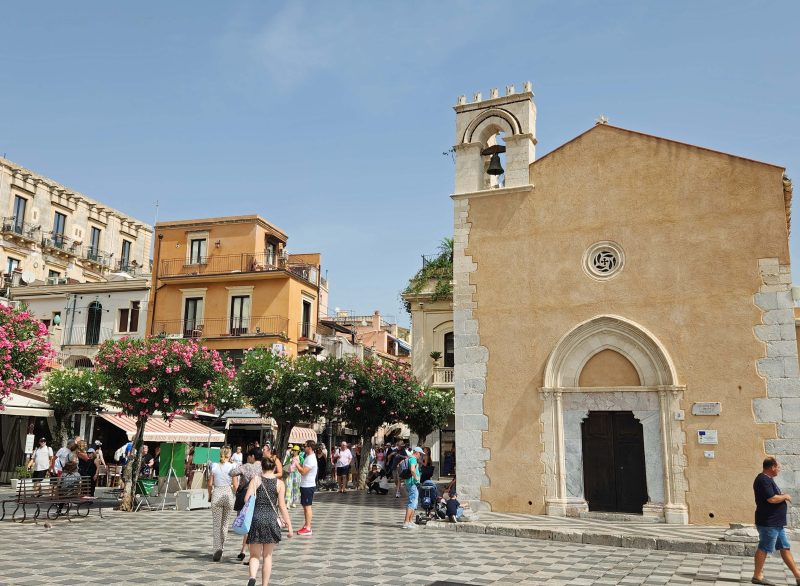
We walked through the city on our way to the ancient Greek Theater and saw some pretty streets and interesting buildings.
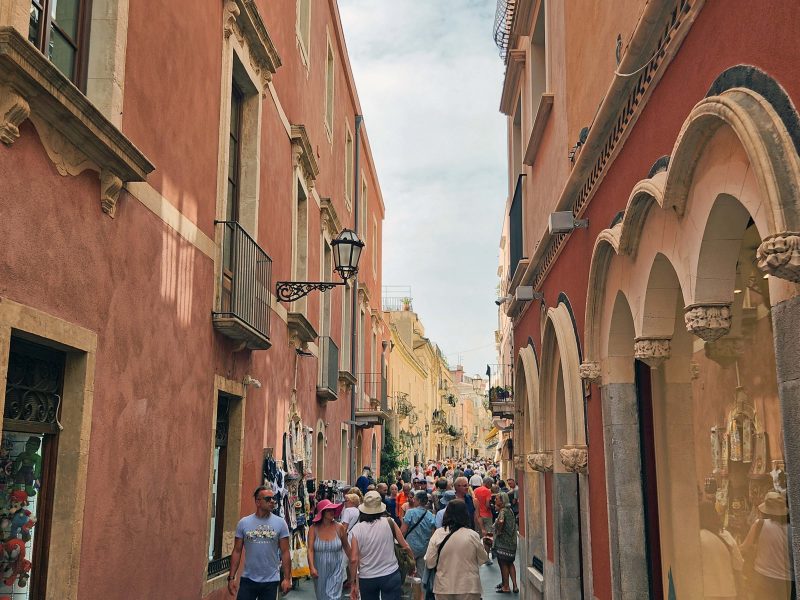

The ancient Greek Theater provides a panoramic view of the sea, the countryside, and the summit of Mt. Etna, Europe’s largest volcano. The theater has been partially restored and is still used for concerts and other events. It has extraordinary acoustics and seats about 6,000 people. In its original form, the theater’s seating capacity was about 12,000 people. Given the scale of the people near the stage, I was obviously standing in the cheap seats to take this picture.
The theater was originally excavated by the Romans, who used it for entertainment—including beheadings and animals eating people. Later, the Greeks used it for plays. All the Greek plays were tragedies because, in their thinking, tragedies taught people about morals and life. The actors wore large masks so that, from a distance (like where I was standing), the audience could tell if they were portraying men or women and could more easily follow the plot.
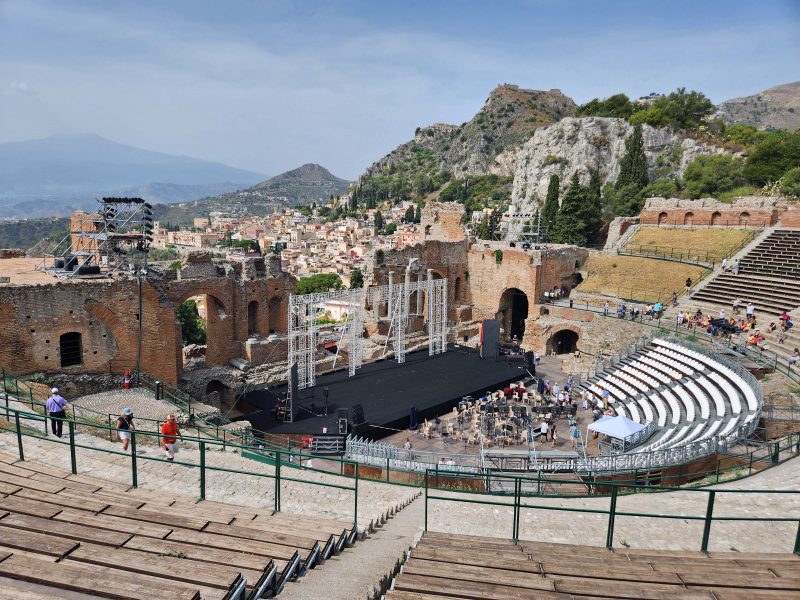
After the theater, our guide left us to spend time on our own. While Ted and I were walking around the theater, we saw these stage prop “rocks.” I think the large one looks like the finger of God.

Yep! They’re props.
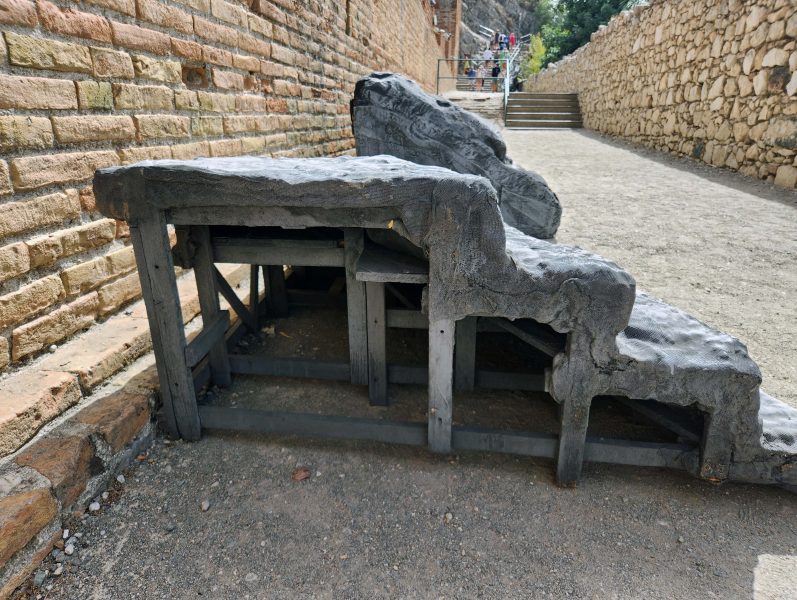
Creative, artistic photography is not my long suit, but I like this picture I took from one of the entrances to the theater. The hazy half mountain on the left of the archway is Mt. Etna.
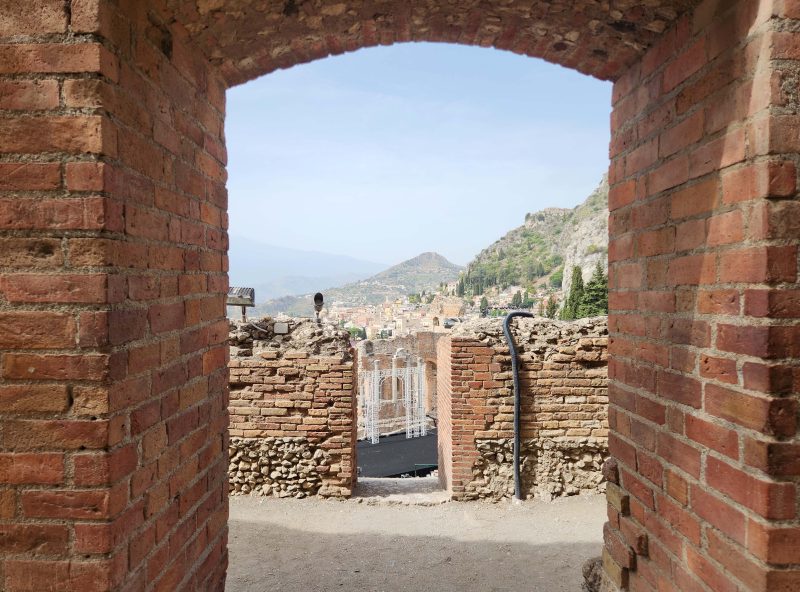
On the back side of the theater, Ted and I (and a few other people) found this shady spot overlooking the Ionian Sea. Our stateroom mini-fridge is stocked daily with, among other things, two snack packets of peanuts. They’re really handy to take along on excursions. There are just enough peanuts in the bag to provide an energy boost in the afternoons. We took a peanut break here and enjoyed the scenery and a nice breeze for a little while.

Re-energized, we headed for the downtown area. Notice the head-shaped vases with flowers in them on the shop windowsill. There’s a local legend that goes along with the vases, and it’s so widespread that the vases have become a representative symbol of Sicily. Here’s the legend.
In Palermo, there lived a very beautiful woman who was dedicated to the care of the plants on her balcony. One day a Moor (Arab) passed her house and fell in love with her. He declared his love and she immediately returned the feeling. Unfortunately, she later learned that he would soon return to his wife and children in the East. Feeling betrayed, she cut off his head during the night and planted basil in it. Then she displayed it on her balcony and her neighbors were so envious, they had earthenware pots built to look just like the head of the Moor.
An alternate ending skips the envy of the neighbors and says that the woman watered the basil with her tears, and it grew so prolifically, that other women wanted a vase like hers. They cut off the heads of the men who cheated on them and, if the men didn’t like this solution, well, too bad! They shouldn’t have cheated on their wives.
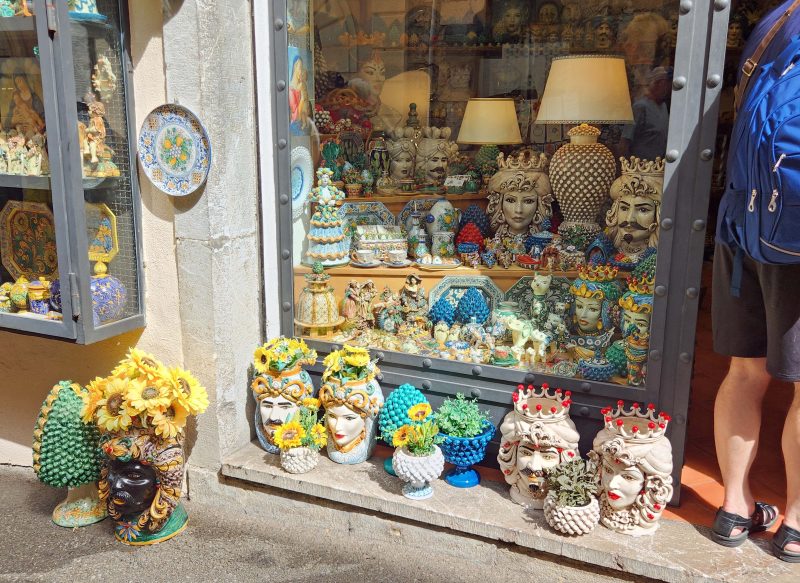
A nearby shop window had these colorful ceramics, another typical product of the area, on display.
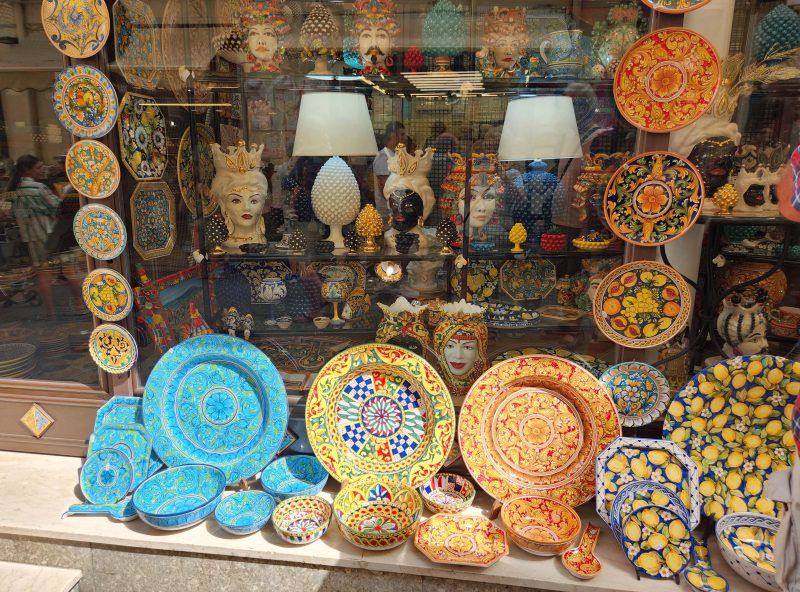
During our time with our guide, she told us the history of the Greeks and wine. (The Greeks ruled Sicily in the 8th century and I think she was Greek.)
According to mythology, the god Dionysus gave the Greeks wine by providing them with grapes that had juice in them. Because wine was given to the Greeks by a god, it’s essential to know how to drink wine as a true Greek. If you don’t know the right way, you’re not worthy of being a Greek. As a knowledgeable Greek, you never dilute wine, but you always drink it with water; you always drink it slowly and with food; and you never get drunk. You start drinking wine when you are three years old, so you’re not a true Greek until then. Of course, there were outdoor cafés everywhere, including on this stairway, and I’m sure they all included wine on their menus.

The balconies on this street were pretty.
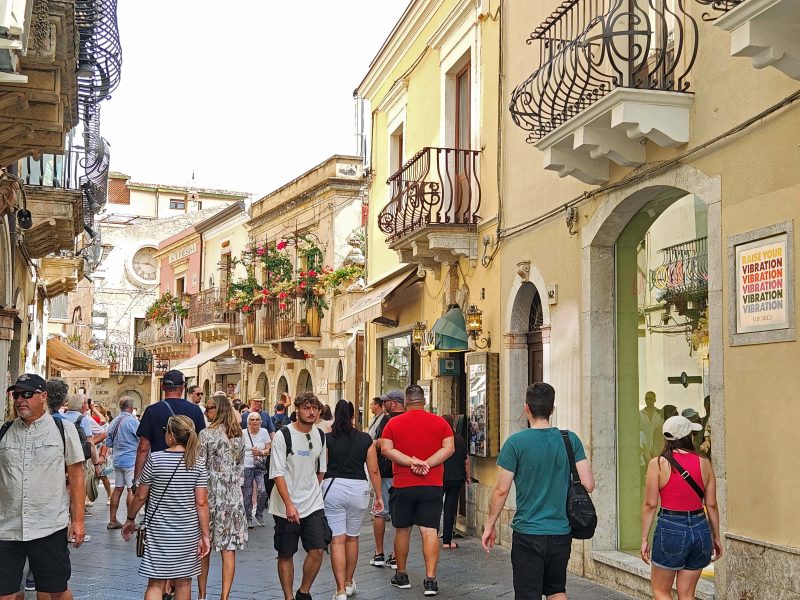
This candy store caught Ted’s and my attention. I couldn’t miss Superman at the entrance, but the second thing I saw was Elvis, so the store merited a closer look. If you take the time, you’ll see that the shop is decorated with images and models of cartoon characters and superheroes.
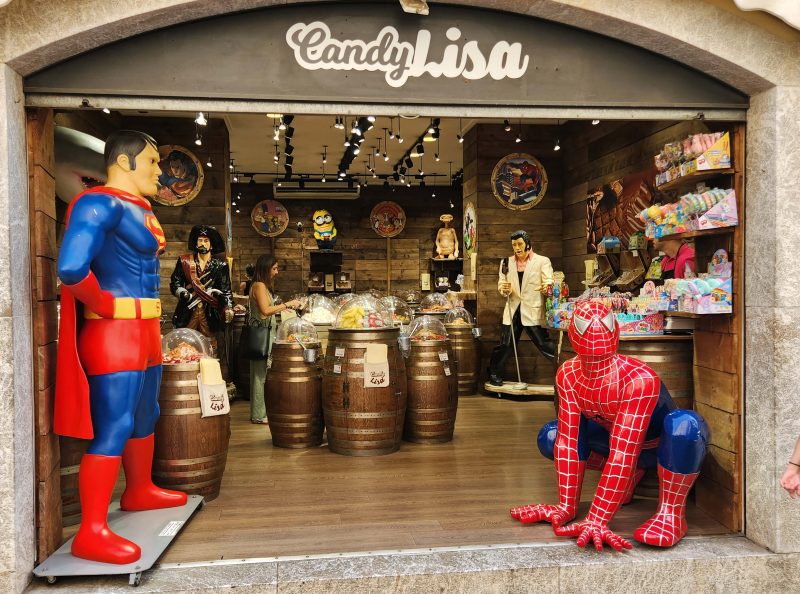
Some things are so pretty, they simply beg to be remembered in a picture.

We had a little travel adventure at the end of today’s excursion. As I mentioned, our guide left us to explore the city on our own, which is not unusual, and she asked us to meet her in the piazza at a given time. All of us were there about ten minutes before the scheduled time, but our guide, walking slowly with a beverage in her hand and chatting with a friend, arrived ten minutes late—20 minutes after the rest of us arrived at the meeting point. The parking lot and the public restrooms were on a lower level (the city is on a mountainside), and the elevator required the guide’s group pass to use it.
Quite a few people had planned to stop at the restrooms before boarding the bus and were waiting for the guide and her elevator pass. What could she do but take us down to the parking level and then wait while those in need used the restrooms? As a result, our bus’s paid parking time ran out, and the garage attendant would not let the bus leave without paying the additional overtime fee. I think it was €20, and our guide had to pay it out of her own funds because she was contracted by Viking and not an employee of the company. We did not have a happy guide on our way back to the ship, but it was her own fault for being late. Maybe she learned to set an earlier meeting time or to arrive at the meeting point on time to allow for restroom usage on the parking level.